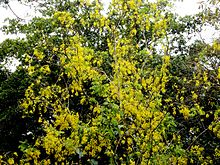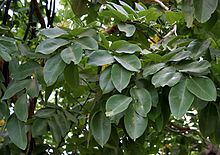You are here
Magnoliopsida
Cassia fistula L.
EOL Text
Perennial, Trees, Woody throughout, Nodules present, Stems erect or ascending, Stems or branches arching, spreading or decumbent, Stems greater than 2 m tall, Stems solid, Stems or young twigs glabrous or sparsely glabrate, Stems or young twigs sparsely to densely hairy, Leaves absent at flowering time, Leaves alternate, Leaves petiolate, Stipules inconspicuous, absent, or caducous, Stipules setiform, subulate or acicular, Stipules deciduous, Stipules free, Leaves compound, Leaves even pinnate, Leaf or leaflet margins entire, Leaflets opposite, Leaflets 10-many, Leaves glabrous or nearly so, Inflorescence panicles, Inflorescence cauliferous, Inflorescence terminal, Inflorescence or flowers lax, declined or pendulous, Bracts very small, absent or caducous, Bracteoles present, Flowers actinomorphic or somewhat irregular, Flowers zygomorphic, Calyx 5-lobed, Calyx glabrous, Petals separate, Petals orange or yellow, Banner petal narrow or oblanceolate, Wing petals narrow, oblanceolate to oblong, Keel tips obtuse or rounded, not beaked, Stamens 9-10, Fertile stamens 6-8, Stamens heteromorphic, graded in size, Stamens completely free, separate, Filaments glabrous, Filam ents S-shaped, Anthers opening by basal or terminal pores or slits, Style terete, Fruit a legume, Fruit unilocular, Fruit indehiscent, Fruit elongate, straight, Fruit oblong or ellipsoidal, Fruit or valves persistent on stem, Fruit coriaceous or becoming woody, Fruit exserted from calyx, Fruit glabrous or glabrate, Fruit 3-10 seeded, Seeds embedded in gummy or spongy pulp, Seeds ovoid to rounded in outline, Seed surface smooth, Seeds olive, brown, or black.
| License | http://creativecommons.org/licenses/by-nc-sa/3.0/ |
| Rights holder/Author | Compiled from several sources by Dr. David Bogler, Missouri Botanical Garden in collaboration with the USDA NRCS NPDC |
| Source | http://plants.usda.gov/java/profile?symbol=CAFI3 |
Fruit: Purgative. Pulp between seeds used as laxative. Seed: Pulverized seeds used for a laxative.
Tree, up to 20 m tall. Bark in young tree smooth and ash coloured becoming rough and dark brown in old. Stipules deltoid, acute, 1-2 mm long, caducous. Rachis 12-25 cm long, terete, glabrous. Leaves compound 22.5-40 cm long, with 3-8 pairs of opposite leaflets, 6-10 (20) cm long, smooth above, hairy below. Flowers arranged in drooping racemes, each raceme c. 10-45 cm long; peduncle 2-10 cm long. Pedicel 3.7-5.8 cm long, slender, slightly hairy or quite smooth, bracts 8-10 mm long, ovate, acute, hairy. Calyx 5, green, folded backward on the stalk, hairy, ovate, 9 mm long. Petals 5, obovate, blunt, distinctly veined. Stamens 10, 3 longest stamens much curled and bear large oblong anthers, 4 smaller medium ones are quite straight, 3 remaining stamens are quite short, erect and sterile. Ovary slender, thinly appressed hairy, style sturdy, stigma punctiform. Pods terete, glabrous, indehiscent, 40-60 cm long, 1.5-2 cm broad, black glossy brown, 40-100 seeded.
| License | http://creativecommons.org/licenses/by-nc-sa/3.0/ |
| Rights holder/Author | eFloras.org Copyright © Missouri Botanical Garden |
| Source | http://www.efloras.org/florataxon.aspx?flora_id=5&taxon_id=200012019 |
"Wood used as fuel wood. The bark is made into a paste with turmeric powder and cumin and the juice is extracted and used to cure nausea and vomiting. The bark also yields an orange dye. Extensive overharvest of bark for trade took place in the past, and now collection of bark is banned.
The wood is very hard, especially used for agricultural implements. Commonly planted in gardens and along roads for ornamental purpose. The fruit pulp is a good laxative. The wood is mixed in preparations to cure dysentery.
"
| License | http://creativecommons.org/licenses/by/3.0/ |
| Rights holder/Author | Keystone Foundation, India Biodiversity Portal |
| Source | http://indiabiodiversity.org/species/show/31155 |
150-1400 m
| License | http://creativecommons.org/licenses/by-nc-sa/3.0/ |
| Rights holder/Author | eFloras.org Copyright © Missouri Botanical Garden |
| Source | http://www.efloras.org/florataxon.aspx?flora_id=110&taxon_id=200012019 |
| This article contains special characters. Without proper rendering support, you may see question marks, boxes, or other symbols. |
Cassia fistula, known as the golden shower tree and by other names, is a flowering plant in the family Fabaceae. The species is native to the Indian subcontinent and adjacent regions of Southeast Asia. It ranges from southern Pakistan eastward throughout India to Myanmar and Thailand and south to Sri Lanka. In literature, it is closely associated with the Mullai (forest) region of Sangam landscape. It is the national tree of Thailand, and its flower is Thailand's national flower. It is also the state flower of Kerala in India and of immense importance amongst the Malayali population. It is a popular ornamental plant and is also used in herbal medicine.
Contents
Description[edit]
The golden shower tree is a medium-sized tree, growing to 10–20 m (33–66 ft) tall with fast growth. The leaves are deciduous, 15–60 cm (5.9–23.6 in) long, and pinnate with three to eight pairs of leaflets, each leaflet 7–21 cm (2.8–8.3 in) long and 4–9 cm (1.6–3.5 in) broad. The flowers are produced in pendulous racemes 20–40 cm (7.9–15.7 in) long, each flower 4–7 cm (1.6–2.8 in) diameter with five yellow petals of equal size and shape. The fruit is a legume, 30–60 cm (12–24 in) long and 1.5–2.5 centimetres (0.59–0.98 in) broad, with a pungent odor and containing several seeds. The tree has strong and very durable wood, and has been used to construct "Ahala Kanuwa", a place at Adams Peak, Sri Lanka, which is made of Cassia fistula (ahala, ehela, or aehaela, ඇහැල in Sinhala [2]) heartwood.
Cultivation[edit]
Cassia fistula is widely grown as an ornamental plant in tropical and subtropical areas. It blooms in late spring. Flowering is profuse, with trees being covered with yellow flowers, many times with almost no leaf being seen. It will grow well in dry climates. Growth for this tree is best in full sun on well-drained soil; it is relatively drought tolerant and slightly salt tolerant. It will tolerate light brief frost, but can get damaged if the cold persists. It can be subject to mildew or leaf spot, especially during the second half of the growing season. The tree will bloom better where there is pronounced difference between summer and winter temperatures.[3]
Pollinators and seed dispersal[edit]
Various species of bees and butterflies known to be pollinators of Cassia fistula flowers, especially carpenter bees (Xylocopa sp.).[4] In 1911, Robert Scott Troup conducted an experiment to determine how the seeds of C. fistula are dispersed. He found that golden jackals feed on the fruits and help in seed dispersal.[5]
Medical use[edit]
In Ayurvedic medicine, the golden shower tree is known as aragvadha, meaning "disease killer". The fruit pulp is considered a purgative,[6][7] and self-medication or any use without medical supervision is strongly advised against in Ayurvedic texts. Though its use in herbalism has been attested to for millennia, little research has been conducted in modern times.
Culture[edit]
The golden shower tree is the state flower of Kerala in India. The flowers are of ritual importance in the Vishu festival of Kerala, and the tree was depicted on a 20-rupees stamp. The golden shower tree is the national flower of Thailand; its yellow flowers symbolize Thai royalty. A 2006-2007 flower festival, the Royal Flora Ratchaphruek, was named after the tree, which is known in Thai as Ratchaphruek (Thai: ราชพฤกษ์) and the blossoms commonly referred to as dok khuen (Thai: ดอกคูน). C. fistula is also featured on a 2003 joint Canadian-Thai design for a 48-cent stamp, part of a series featuring national emblems.[3]Cassia acutifolia, the pudding-pipe tree, furnishes the cassia pods of commerce.[8]
Vernacular names[edit]
Being so conspicuous and widely planted, this tree has a number of common names. In English, it is also known as the golden shower cassia and also as Indian laburnum or golden shower. It is known in Spanish-speaking countries as caña fistula.
Names from its native range and surrounding regions include:[9]
- Arabic: khiār shambar (خيار شمبر)
- Assamese: xonaru (সোণাৰু)
- Bengali: sonalu, bandar lathi, amaltas
- Burmese: ngu wah
- Chinese: ā bó lè (阿勃勒: Taiwan), là cháng shù (sausage tree, 腊肠树)
- Gujarati: garmalo (ગરમાળો)
- Hindi: amaltās (अमलतास), bendra lathi (or bandarlauri), dhanbaher (or dhanbohar), girimaloah
- Japanese: nanban saikachi (ナンバン サイカチ, Kanji: 南蛮皀莢)
- Khmer: reachapreuk (រាជព្រឹក្ស - rajavriksha / លឿងរាជ្យ / រាជ)
- Kannada: kakke (ಕಕ್ಕೆ ಮರ)
- Lao: khoun (ຄູນ)
- Marathi: bahava (बहावा)
- Malayalam: kanikkonna (or kani konna കണിക്കൊന്ന), Vishu konna(വിഷുക്കൊന്ന) also Ophirpponnu (ഓഫീർപ്പൊന്ന്) or Karnikaram (കർണ്ണികാരം) and Konnappoo (കൊന്നപ്പൂ).
- Meitei (Manipuri): chahui
- Nepali: amaltash, rajbriksya
- Oriya: sunari (ସୁନାରି)
- Sanskrit: aragvadha, chaturangula, kritamala, suvarnaka
- Sinhalese: aehaela, ඇහැල (or ahalla), ehela
- Tamil: konrai (கொன்றை)
- Telugu: raela (రేల)
- Thai: rachapruek (ราชพฤกษ์), khun (คูน), dok khuen (ดอกแคน)
The name was erroneously used by John Patrick Micklethwait Brenan for the Kenyan shower cassia, correctly known as C. afrofistula. Similarly, Francisco Manuel Blanco misapplied Linnaeus's name to the apple-blossom cassia C. javanica ssp. javanica.[10]
References[edit]
- ^ "The Plant List: A Working List of All Plant Species". Retrieved June 19, 2014.
- ^ sinhala botany website
- ^ a b "Cassia Fistula (aburnum, Purging Fistula, Golden Shower, Amaltas)", Ayurveda - Herbs (4 to 40), retrieved 2011-01-20
- ^ Murali, KS (1993) Differential reproductive success in Cassia fistula in different habitants-A case of pollinator limitations? In: Current Science (Bangalore), 65 (3). pp. 270-272.
- ^ Troup, R.S. (1911).Silviculture of Indian Trees. Published under the authority of His Majesty’s Secretary of State for India in Council. Oxford Clarendon Press
- ^ Pole, Sebastian (2012). Ayurvedic Medicine: The Principles of Traditional Practice. Singing Dragon. p. 129. ISBN 1848191138. Retrieved November 10, 2012.
- ^ Bhagwan Dash, Vaidya (2002). Materia Medica Of Ayurveda. India: B. Jain. pp. 41–42. Retrieved November 10, 2012.
- ^ U. S. Department of Agriculture, William Saunders; Catalogue of Economic Plants in the Collection of the U. S. Department of Agriculture; Washington D. C.; June 5, 1891
- ^ Multilingual Multiscript Plant Name Database (MMPND) (2005): Cassia fistula L.. Version of 12/01/2005. Retrieved 2007-DEC-20
- ^ International Legume Database & Information Service (ILDIS) (2005): Genus Cassia. Version 10.01, November 2005. Retrieved 2007-DEC-20.
| License | http://creativecommons.org/licenses/by-sa/3.0/ |
| Rights holder/Author | Wikipedia |
| Source | http://en.wikipedia.org/w/index.php?title=Cassia_fistula&oldid=642733146 |
"Habit: A medium-sized, deciduous tree with drooping branchlets, upto 12m."
| License | http://creativecommons.org/licenses/by/3.0/ |
| Rights holder/Author | Keystone Foundation, India Biodiversity Portal |
| Source | http://indiabiodiversity.org/species/show/31155 |
French: casse des Antilles. FG Creole: casse. Surinam: goudenregen.
Habit: Tree
Plant introduced from tropical Asia to French Guiana.







